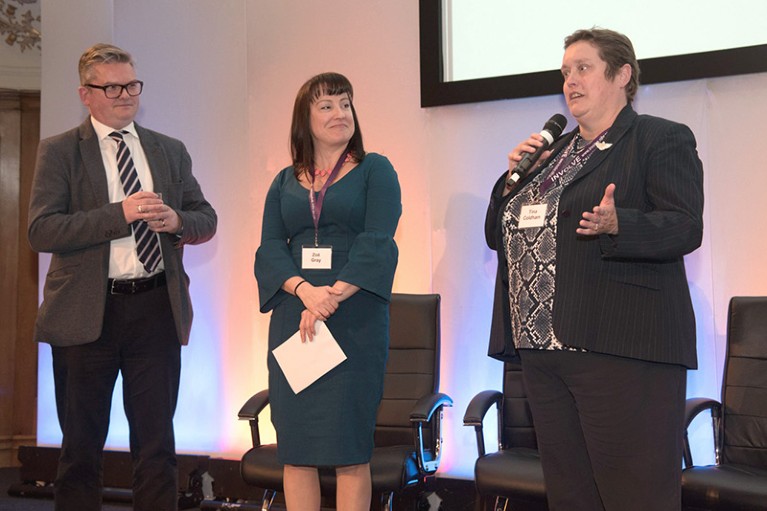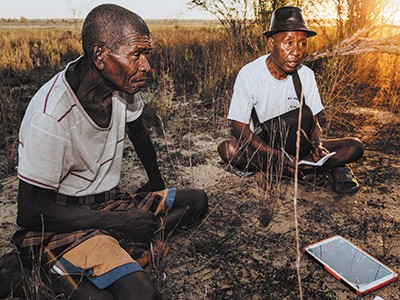
Tina Coldham (right) speaks at an INVOLVE conference.Credit: National Institute for Health Research
Tina Coldham chairs the advisory group of INVOLVE, a Southampton-based organization that is part of the publicly funded UK National Institute for Health Research (NIHR). INVOLVE focuses on engaging the public and encouraging people to participate in research. Nature asked her how she moved into co-production, and for advice on how other scientists can do the same.
What is co-production of research?
It’s research in which the decision-making is jointly owned by both researchers and the public, who work together to achieve a shared understanding. That might mean deciding what the actual research is about, but also understanding that we have positions of power because of the jobs we have or don’t have. It’s about getting everybody around the table so you’re valuing the knowledge everybody has.
What do you mean by ‘positions of power’?
If you’re an ordinary person off the street, dealing with people who have ‘doctor’ or ‘professor’ in their title can be rather overwhelming. That’s the key thing. Researchers have to understand that, and co-production tries to break down that barrier.
Nature special: Co-production of research
Why is this important?
I think it means we will research things that matter to the public — making sure that the research is rooted in the real-life experiences of people with that lived experience. Not in things that, although they might be important and life-affirming for researchers, won’t immediately help patients now. Research sometimes looks at things that the layperson will say, “I already know that anecdotally,” or, “That’s actually no help to me.”
Can you give an example?
I got into this through having long-term mental-health problems. I found that a psychiatrist’s answer was just medication: different dosages, and if that didn’t work, you moved onto different medication. It all seemed a really blunt tool, and I was still struggling with my mental health, so I joined a local community development project that was looking into better understanding mental health.
Co-production is about exploring new avenues and allowing people to take part in research — to help shape it. There is less waste and more relevance to those that it matters to most.
In February, INVOLVE published guidance on co-producing a research project. What were its main recommendations?
That the public, researchers and health professionals be empowered and better supported to work together in the future.
How did you get this job?
I went from being a passive patient to being more in control of my situation after joining the community-development project. I became involved as part of a group that looked at mental-health nursing at my local university, the University of Southampton, before moving on from there.
Any advice for researchers willing to try?
Demystify your work. Try to think about what you’re saying, and bring it into layperson’s terms, which can be quite a challenge. But when you do that and sit people down and say “this is what we’re doing”, people do understand. It might just take more time, or you might need to give them training. But you’re going to get more-interesting research and more-applicable outcomes that others can use in looking at health issues.
I’ve been doing participatory research for some time now; I’ve learnt that if research is carried out co-productively, it can lead you to new areas of learning and appreciation for one another.
What can journals and funders do to support co-production of research?
Journals can continue to highlight the importance of co-production and publish examples in which it’s worked well, and funders can insist that co-production be a feature of any commissioned research.
How can members of the public involve themselves in your research?
Members of the public can get in touch with INVOLVE at www.invo.org.uk/ or they can find out who their local Patient and Public Involvement Officer is at their local Regional Design Service of the NIHR.
Can you give an example of when co-production worked well?
I can remember hearing about an asthma study that was proposing some really invasive tests, and the patients working with the researchers turned around and said, “Well, no, we’re not going to do that. We don’t want things shoved down our throats. Can’t you do that another way?”

 Nature special: Co-production of research
Nature special: Co-production of research
 The best research is produced when researchers and communities work together
The best research is produced when researchers and communities work together
 Farmers transformed how we investigate climate
Farmers transformed how we investigate climate
 How three research groups are tearing down the ivory tower
How three research groups are tearing down the ivory tower
 Co-production from proposal to paper
Co-production from proposal to paper
 Craft metrics to value co-production
Craft metrics to value co-production






